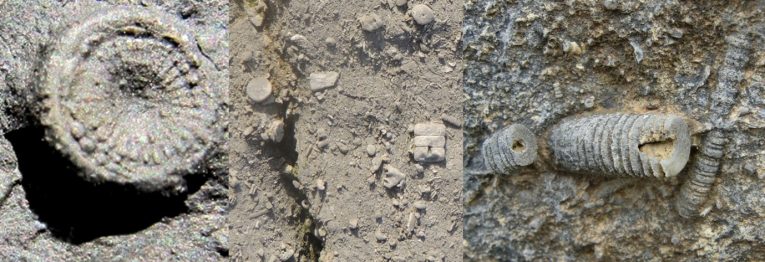Fossil crinoids – Finding the ‘new’ in the old
20.07.2022The limestone of the Burren is packed with fossils. It is reasonable to say it is made of fossils. A lot of the time we don’t see them because the surface of the limestone is covered by algae or lichen but just below the surface lie the remains of animals that lived in a tropical shallow sea, 330 million years ago. And of all the fossils in the limestone, bits of fossil crinoids are the most abundant.
Crinoids come in a variety of forms, the most typical being a long narrow stem, with a globular body or ‘calyx’ on top and multiple long feathery-looking arms extending upwards from that. They look a bit like ferns and are also known as ‘sea-lilies’ or ‘feather stars’. Crinoids were abundant in the Carboniferous shallow seas and they are still found in the world’s oceans today although generally in deeper water, so they are rarely seen. Crinoids belong to the echinoderms, so they are closely related to sea urchins, sand dollars, starfish and even sea cucumbers.
Like many sea creatures, crinoids make their hard parts out of the mineral calcite. It is the hard parts that survive to become fossils. For crinoids, their hard parts are a series of discs stacked on top of each other that make up the skeleton of the stem and arms of the animal. During life, these are attached together by ligaments giving the animal a degree of flexibility to wave around in ocean currents, where they use their arms to collect food from the water.

Fossil crinoids from the Burren. Left, fossil crinoid ossicle unique to Doolin; centre, typical preservation of crinoid bits; right, short section of intact stem.
Unfortunately, most fossil crinoids in the Burren limestone are not complete, they were separated into their individual pieces shortly after they died, when the connecting tissues had decomposed or were eaten. These pieces of crinoid were then moved around on the seafloor by waves and currents and broken up even further by burrowing organisms or scavengers before being buried and turned to rock. These individual circular sections of stem are known as ‘ossicles’ and vary in size from 1mm to about 20mm in diameter. When alive, the stems can be over 1m long but after death they break up, however, sometimes short sections of stem survive intact. While finding a complete fossil crinoid in the Burren is unlikely, because each crinoid has hundreds of individual pieces, this means there are a lot of crinoid pieces to be found.
When palaeontologists find ‘new’ species, they are of course finding old fossils and just giving them a new name. My Geopark research with Dr. Steve Donovan on fossil crinoids has already identified a ‘new’ 326 million year old species (Heloambocolumnus harperi) from Doolin, a crinoid unknown anywhere else in the world. As I find more specimens, this ‘new’ material should provide even more ‘new’ fossil discoveries in the coming years.
Dr. Eamon Doyle, geologist for the Burren and Cliffs of Moher UNESCO Global Geopark.